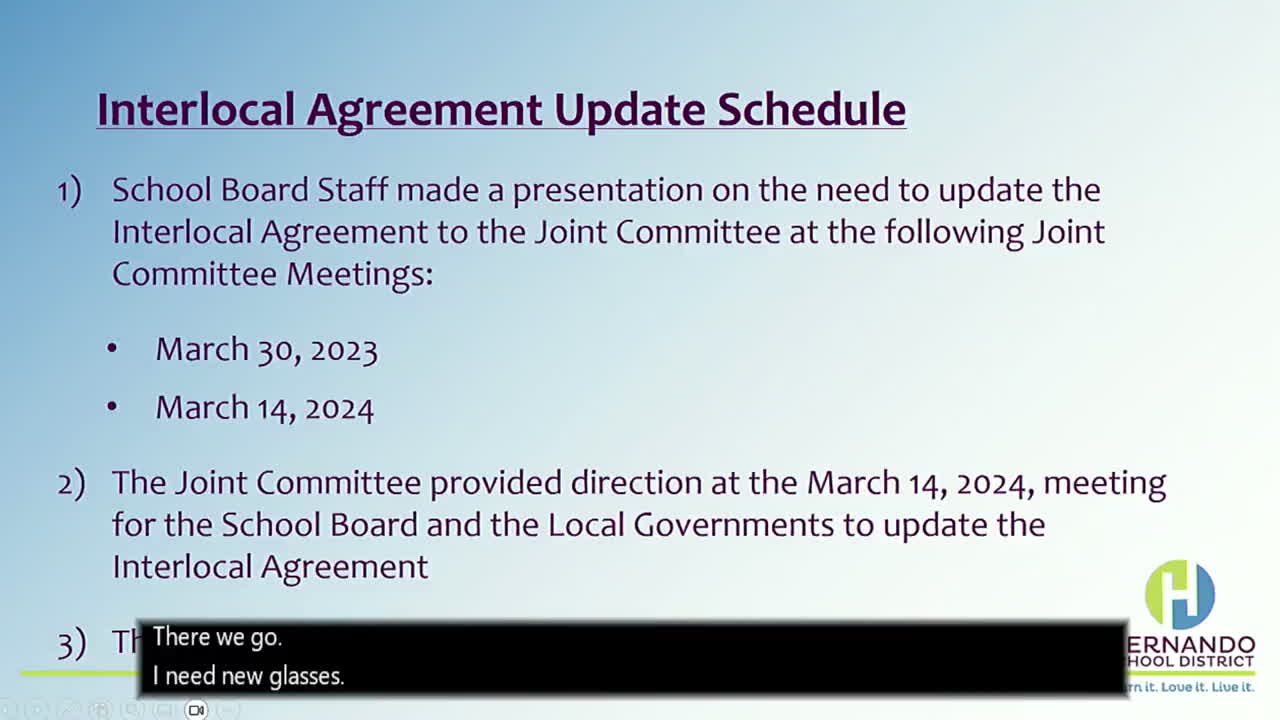Officials work toward updated interlocal agreement on school planning, concurrency and impact fees
October 17, 2025 | Hernando County, Florida
This article was created by AI summarizing key points discussed. AI makes mistakes, so for full details and context, please refer to the video of the full meeting. Please report any errors so we can fix them. Report an error »

Attorneys and planners presented a proposed update to the 2009 interlocal agreement that governs coordination between Hernando County, the cities and the school district on school siting, concurrency and impact fees.
Chris Wilson, outside counsel working with the district, and attorney Jim Lipsey summarized changes that staff say align the agreement with current Florida statutes and county comp‑plan policy and that remove obsolete code references. Key changes described include a shorter, more flexible working‑group schedule (two staff working group meetings per year, plus an annual, public oversight meeting), clearer processes for school site notice requirements, and incorporation of long‑term relocatables into level‑of‑service (LOS) calculations.
Wilson and Lipsey said the updated ILA would also include an impact‑fees section for administration, collection, remittance and audit of school impact fees — a topic that previously had no interlocal protocol in place. They said the draft clarifies that proportionate share mitigation will follow statute (a market‑value, dollar‑for‑dollar credit mechanism implemented via developer vouchers) and proposes a de minimis exemption for very small projects (10 units or fewer) and for age‑restricted communities.
Lipsey and local planners said the draft proposes making the oversight committee a smaller elected‑official body (the draft shows three appointees per governmental board, a group that would meet annually) and reiterated that staff recommended timing for the review cycle to provide input to budgets and the district’s five‑year work plan. Michelle Miller, Hernando County planning, said the county and school staff are also coordinating timing so county and school concurrency windows will align and be easier to track.
Why it matters: The ILA update touches development review, developer mitigation obligations and the administration of fees that fund school capacity. The proposed draft aims to reduce review time for proportionate‑share mitigation, standardize fee handling, and give staff and elected leaders a more predictable annual process for planning school capacity and capital projects.
Next steps: Wilson said staff from the city, county and school district will meet every two weeks to finish a final draft, then bring it back to each body for consideration. Commissioners and board members discussed whether to keep the broader interlocal meeting format in place alongside the proposed smaller oversight committee; no final change was adopted at the meeting.
Chris Wilson, outside counsel working with the district, and attorney Jim Lipsey summarized changes that staff say align the agreement with current Florida statutes and county comp‑plan policy and that remove obsolete code references. Key changes described include a shorter, more flexible working‑group schedule (two staff working group meetings per year, plus an annual, public oversight meeting), clearer processes for school site notice requirements, and incorporation of long‑term relocatables into level‑of‑service (LOS) calculations.
Wilson and Lipsey said the updated ILA would also include an impact‑fees section for administration, collection, remittance and audit of school impact fees — a topic that previously had no interlocal protocol in place. They said the draft clarifies that proportionate share mitigation will follow statute (a market‑value, dollar‑for‑dollar credit mechanism implemented via developer vouchers) and proposes a de minimis exemption for very small projects (10 units or fewer) and for age‑restricted communities.
Lipsey and local planners said the draft proposes making the oversight committee a smaller elected‑official body (the draft shows three appointees per governmental board, a group that would meet annually) and reiterated that staff recommended timing for the review cycle to provide input to budgets and the district’s five‑year work plan. Michelle Miller, Hernando County planning, said the county and school staff are also coordinating timing so county and school concurrency windows will align and be easier to track.
Why it matters: The ILA update touches development review, developer mitigation obligations and the administration of fees that fund school capacity. The proposed draft aims to reduce review time for proportionate‑share mitigation, standardize fee handling, and give staff and elected leaders a more predictable annual process for planning school capacity and capital projects.
Next steps: Wilson said staff from the city, county and school district will meet every two weeks to finish a final draft, then bring it back to each body for consideration. Commissioners and board members discussed whether to keep the broader interlocal meeting format in place alongside the proposed smaller oversight committee; no final change was adopted at the meeting.
View full meeting
This article is based on a recent meeting—watch the full video and explore the complete transcript for deeper insights into the discussion.
View full meeting